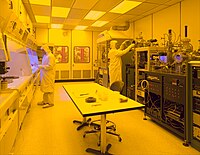
Photo from wikipedia
The aim of this work is the development of a novel framework for structural optimization using bio-inspired remodelling algorithm adapted to additive manufacturing. The fact that polylactic acid (PLA, E = 3145… Click to show full abstract
The aim of this work is the development of a novel framework for structural optimization using bio-inspired remodelling algorithm adapted to additive manufacturing. The fact that polylactic acid (PLA, E = 3145 MPa (Young’s modulus) according to the supplier for parts obtained by injection) shows a similar parameterized behavior with ductile metals, in the sense that both materials are characterized by a bi-linear elastic-plastic law, allows to simulate and prototype parts to be further constructed in ductile metals at a lower cost and then be produced with more expensive fabrication processes. Moreover, cellular materials allow for a significant weight reduction and therefore reduction of production costs. Structural optimization algorithms based on biological phenomena were used to determine the density distribution of the infill density of the specimens. Several simple structures were submitted to distinct complex load cases and analyzed using the mentioned optimization algorithms combined with the finite element method and a meshless method. The surface was divided according to similar density and then converted to stereolitography files and infilled with the gyroid structure at the desired density determined before, using open-source slicing software. Smoothing functions were used to smooth the density field obtained with the remodeling algorithms. The samples were printed with fused filament fabrication technology and submitted to mechanical flexural tests similar to the ones analyzed analytically, namely three- and four-point bending tests. Thus, the factors of analysis were the smoothing parameter and the remodeling method, and the responses evaluated were stiffness, specific stiffness, maximum force, and mass. The experimental results correlated (obtaining accuracy of 35% for the three-point bending load case and 5% for the four-point bending load case) to the numerical results in terms of flexural stiffness and it was found that the complexity of the load case is relevant for the efficiency of the functional gradient. The fused filament fabrication process is still not accurate enough to be able to experimentally compare the results based of finite element method and meshless method analyses.
Journal Title: Proceedings of the Institution of Mechanical Engineers, Part L: Journal of Materials: Design and Applications
Year Published: 2021
Link to full text (if available)
Share on Social Media: Sign Up to like & get
recommendations!